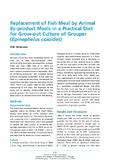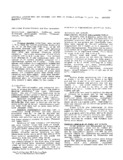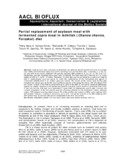| dc.contributor.author | Eusebio, Perla S. | |
| dc.contributor.author | Coloso, Relicardo M. | |
| dc.date.accessioned | 2013-11-16T08:27:09Z | |
| dc.date.available | 2013-11-16T08:27:09Z | |
| dc.date.issued | 1998 | |
| dc.identifier.citation | Eusebio, P. S., & Coloso, R. M. (1998). Evaluation of leguminous seed meals and leaf meals as plant protein sources in diets for juvenile Penaeus indicus. The Israeli Journal of Aquaculture-Bamidgeh, 50(2), 47-54. | en |
| dc.identifier.issn | 0792-156X | |
| dc.identifier.uri | http://hdl.handle.net/10862/1741 | |
| dc.description.abstract | The potential of locally available legumes (white cowpea, Vigna unguiculata, and green mung-bean, Vigna radiata) and leaf meals (papaya, Carica papaya, and cassava, Manihut esculenta) in combination with defatted soybean meal as protein sources was evaluated in juvenile Penaeus indicus. The feedstuffs were included in practical diets for P. indicus, replacing 9% of the protein in the basal diet. Juvenile P. indicus (mean initial weight 0.08±0.01 g) were fed the practical diets for 61 days. Shrimp fed the control diet had the highest weight gain and specific growth rate, which did not significantly differ (p>0.05) from those of shrimp fed white cowpea meal, papaya leaf meal and cassava leaf meal. Survival of the control shrimp was significantly higher (p<0,05) than that of shrimp fed cassava and papaya leaf meals but comparable to that of shrimp fed white cowpea meal. The growth of shrimp given green mungbean meal was comparable to that of shrimp fed papaya leaf meal, however the shrimp fed mungbean meal had the lowest survival.
The apparent protein digestibility (APD) of white cowpea meal (87%) was significantly higher (p<0.05) than that of the control (82%) and cassava leaf meal (77%) based diets . However, the APD of the white cowpea meal based diet was comparable to those of the papaya leaf meal and green mungbean meal based diets. Results suggest that, besides digestibility, other factors such as the amino acid balance of the diet and the amount of anti-nutritional factors may influence the growth and survival of P. indicus. | en |
| dc.language.iso | en | en |
| dc.publisher | Society of Israeli Aquaculture and Marine Biotechnology | en |
| dc.subject | Carica papaya | en |
| dc.subject | Penaeus indicus | en |
| dc.subject | Vigna radiata | en |
| dc.subject | Vigna unguiculata | en |
| dc.subject | Indian white prawn | en |
| dc.subject | papayas | en |
| dc.subject | cowpeas | en |
| dc.subject | leaf meal | en |
| dc.subject | soybeans | en |
| dc.title | Evaluation of leguminous seed meals and leaf meals as plant protein sources in diets for juvenile Penaeus indicus | en |
| dc.type | Article | en |
| dc.citation.volume | 50 | |
| dc.citation.issue | 2 | |
| dc.citation.spage | 47 | |
| dc.citation.epage | 54 | |
| dc.citation.journalTitle | The Israeli Journal of Aquaculture-Bamidgeh | en |
| dc.subject.asfa | diet | en |
| dc.subject.asfa | feed composition | en |
| dc.subject.asfa | feeding experiments | en |
| dc.subject.asfa | proteins | en |
| dc.subject.asfa | shellfish culture | en |
| dc.subject.asfa | shrimp culture | en |
| dc.subject.asfa | digestibility | en |
| dc.subject.asfa | digestion | en |
| dc.subject.scientificName | Manihot esculenta | en |



